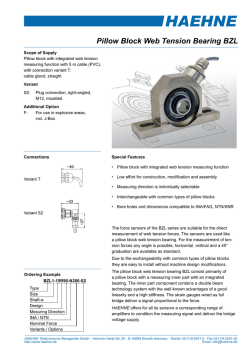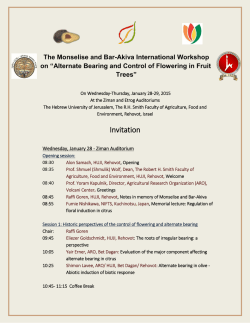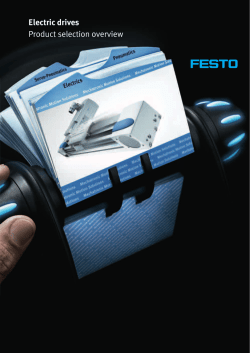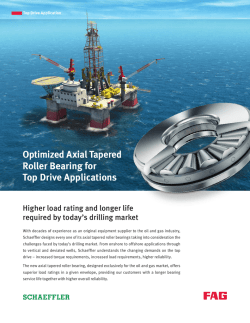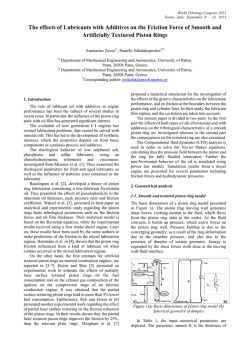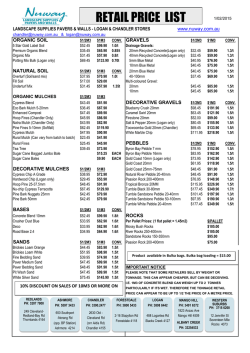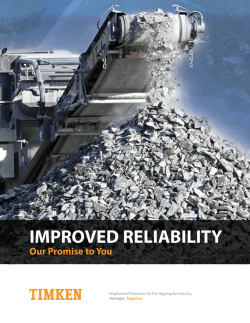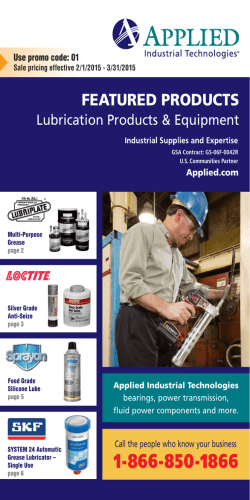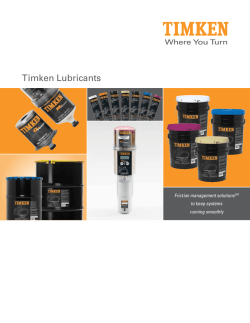
Selecting the correct lubrica
BEST PRACTICES Mike Johnson / Contributing Editor Selecting the correct lubrica Lubricant selection for plain bearing applications requires consideration of many inter-related machine conditions. I KEY CONCEPTS: H[ZkY_d]bkXh_YWdji[b[Yj_ed for a plain bearing down to practical guidance is difficult. Plain bearing design includes 20-plus variables, including aspects of build design and materials and lubricant considerations. FbW_dX[Wh_d]iYWdX[ki[Z_d a variety of applications; however, there is no single set of criteria that can be used. Selection depends on the equipment design and operating conditions. =h[Wi[i[b[Yj_edX[]_dim_j^ consideration of the oil. Heavy oils are used to formulate greases used for manual lubrication of plain bearings in high-duty service. 24I;FJ;C8;H(&&. n the August TLT we discussed element bearings in the first of two articles addressing lubricant selection. This month we’ll provide guidelines that can be followed to select lubricants with the correct chemical and viscometric qualities necessary for long-term, reliable operation of plain bearings. Reducing lubricant selection for a plain bearing down to a few pages of practical guidance is difficult. Plain bearing design includes 20-plus variables, including aspects of the build design and materials (bearing size, shaft radius, clearance, frictional force, friction coefficient, shaft speed, eccentricity, etc.) and the lubricant considerations (viscosity, viscosity index, pressure viscosity index, lubricant-specific heat, temperature, supply rate, egress rate, recirculation flow rate, etc.). This article provides a simplistic overview of the broad aspects of lubricant selection. For those with an appetite for details, I recommend Dr. Michael Khonsari’s The Tribology Data Handbook.1 A less detailed review is provided effectively by Michael J. Neale in The Tribology Handbook, 2nd Edition.2 MI>FK?B>OFKDP Plain bearings and bushings come in a wide variety of shapes, sizes, types of surface contact modes, material compositions and operating profiles, including: UÊ -}iÃ`i` UÊ ÕLiÃ`i` UÊ 6iÀÌV>Êà >vÌ UÊ ÀâÌ>Êà >vÌ UÊ -`Ê ÕÃ} UÊ -«ÌÊ ÕÃ} UÊ V i`Ê ÕÃ} UÊ / ÊÜ> UÊ / VÊÜ> JH?8EBE=OBK8H?97J?EDJ;9>DEBE=O MMM$IJB;$EH= nt for plain UÊ UÊ UÊ UÊ UÊ UÊ UÊ UÊ bearings 6iÀÌV>ÞÊ>`i` ÀâÌ>ÞÊ>`i` / ÀÕÃÌÊLi>À}à -i}iÌi`ÊÌ ÀÕÃÌÊLi>À}à -« iÀV>ÊLi>À}ÃÊ>`ÊLÕà }à "ÃV>ÌÀÞÊLi>À}à i>ÀÊLi>À}à >ÊÌÃÊ>`ÊÀi° Machine design textbooks, including the texts noted above, dedicate significant space to the illustration of the differences between the design, installation and application of these varied types of components. Lubricant type and grade are two of the many criteria that represent variables that must be solved in order to arrive at a reliable and useful design. Plain or journal bearings are used for high radial loads (perpendicular to the axis of the shaft) and low- to highspeeds. Typical applications include turbines, large milling systems, engine cranks, compressors, gearboxes, shaft bearing supports, etc. Every journal bearing has some common design characteristics, as shown in Figure 1. Figure 2 | Journal bearing construction (Courtesy of Trico Corp.) IR?OF@>QFLKOBDFJB Figure 1 | Pillow-block style journal bearing (Courtesy of Trico Corp.) The components that are separated by the oil film in a plain bearing are the bearing liner and the shaft. The shaft is composed of high-quality, wear-resistant, structurally strong steel. The bearing liner may be made of a single layer or multiple layers, depending on the design features of the equipment (see Figure 2). MMM$IJB;$EH= If the journal bearing is assumed to be steadily loaded, and flow is laminar (non-turbulent) and the fluid is incompressible and linearly viscous (Newtonian) and there are no transient effects, then the dimensionless Reynolds equation is used to calculate the design requirements.3 Under normal operating conditions, the lubrication regime is a hydrodynamic full-fluid film. A hydrodynamic film occurs when there is sufficient lubricant between the lubricated surfaces at the point of loading to form a fluid wedge that separates the sliding surfaces. In this state, the lubricated components do not touch each another, reducing friction and wear. In the March TLT we explained this idea and characterized this in the form of the Stribeck Curve. This condition is represented by the equation Z*N/P, where Z = viscosity, N = speed (rpm) and P = load. Figure 4 is a representation of the conditions that occur when plain surfaces accelerate JH?8EBE=OBK8H?97J?EDJ;9>DEBE=O I;FJ;C8;H(&&.25 Operating under proper speed, surface area, viscosity and oil volume, a plain bearing can support very heavy loads. to normal speeds. The box at the top left of Figure 3 reflects a state called Boundary Film condition. The box on the lower right side of Figure 3 represents a state of complete surface separation that occurs once the machine has reached its normal operating speed and load, and the viscosity selected for the machine is appropriate for those conditions. A state that lies between full (boundary) contact and full (hydrodynamic) fluid separation can occur within many maFigure 3 | The Stribeck Curve (Courtesy of Lubcon Consult GMBH) chine types, particularly slowly gle equation that can be used to estimate the ideal lubricant moving, heavily loaded plain bearings. This is referred to as viscosity for a state of operating conditions, the following Mixed Film condition. This condition may occur in response approximation gives an estimate of what the final outcome to changes in surface area, machine running speed, sump opershould be. ating temperature or in response to variations in loading (AKA The first step is to estimate the machine’s surface speed, shock-loading) that can collapse the film, resulting in physiu. That estimate is done as follows: cal contact of machine surfaces. Figure 4 depicts the changes in relative position of two interacting surfaces, as the machine moves from a dead stop to its full operating speed. Values r represents average surface roughness, and h represents film thickness. Where u = surface speed d = bore diameter, meters SFP@LPFQVOBNRFOBJBKQP n = shaft speed, revolutions per second Operating under proper speed, surface area, viscosity and oil = 3.1415 volume, a plain bearing can support very heavy loads. The balance between these conditions is important. If the load or The next step is to estimate the machine’s unit surface the speed changes, the lubricant viscosity must be adjusted pressure, based on machine total load in kilonewtons per to compensate for the change. While there is no simple, sinsquare meter of surface area. u = * d * n h=combined height of asperities or surface roughness r=height of asperity or roughness Figure 4 | States of machine surface separation based on change in film thickness 26I;FJ;C8;H(&&. JH?8EBE=OBK8H?97J?EDJ;9>DEBE=O MMM$IJB;$EH= W = —— l*d Where = pressure, kN/m2 l = bearing width d = shaft diameter W = load, kN (Kilonewtons) Once known these values can be plotted on a table for a rough estimate of minimum allowable viscosity, as shown by the red and blue lines on Figure 5.4 The target viscosity is noted on the Y axis, shown as 30 cPs (centipoise) at the machine average operating temperature. The reliability engineer still needs to evaluate available lubricants to assure that the selected target, in fact, will provide at least 30 cPs at operating temperature. Note: This is intended only to be a rough approximation for the sake of illustrating the principles behind lubricant selection. Please consult with a lubrication engineering professional prior to attempting to make any change in the lubricant selection for any actual operating machines. LQEBO@LKPFABO>QFLKP The final lubricant type decision should include considerations for oxidation stability, corrosion protection, wear protection, water and airseparation properties, etc. Because plain bearings can be used in a variety Figure 5 | Viscosity estimation chart based on actual speed and unit loads (Courtesy of The of applications, there is no single set Tribology Handbook, Second Edition, Michael J. Neale) of criteria that can be used. Selection depends on the equipment design and operating conditions. Plain bearings are normally oillubricated but may be lubricated with grease for slow-speed the task. equipment, particularly if they are subject to frequent starts Grease selection begins with consideration of the oil. and stops or the bearings are physically difficult to reach. Heavy oils are used to formulate greases used for manual The type and amount of grease depends on the replenlubrication of plain bearings in high-duty service. After the ishment rate of the body of grease that is held within the target viscosity has been established, the soap thickener, oxidynamic clearances. Equipment with poor sealing characdation and rust characteristics, worked consistency properteristics may require a heavier body of lubricant and more ties, pumpability (for automatic systems) and load-bearing frequent replenishment cycles. Under manual (intermittent) (AW) properties are considered. For long resupply intervals relubrication, the volume and the frequency are influenced and obvious intermittent loading, solid-film agents such as by operating conditions, grease quality and available time for molybdenum disulfide or graphite may be incorporated. The 28I;FJ;C8;H(&&. JH?8EBE=OBK8H?97J?EDJ;9>DEBE=O MMM$IJB;$EH= solid additives serve to mechanically prevent metal contact in mixed film and boundary lubrication conditions. Lubricants should be applied to the bearing in front of the load zone and at the location of the grease grooves used for lubricant distribution. Plain bearings are normally oil-lubricated but may be lubricated with grease for slow-speed equipment. @LK@IRPFLK Lubricant selection, particularly viscosity selection, for journal bearings and other sliding surfaces is not a simple task. The correct viscosity selection is integral to a variety of other design objectives and is established through careful iterative calculations. The principle for journal bearings is simple: As machine speed increases, the lubricated surfaces feed lubricant into the load zone at a rate high enough to cause the lubricant to pile up and create a pressure wedge. Once the pressure is high enough, it lifts and separates the machine surfaces. Boundary, mixed film and hydrodynamic films are created during routine operation of sliding bearings. The lubricant film can be calculated based on the Reynolds equation once all the factors are known. After selecting the optimum viscosity, considerations are made for shock-loading, corrosion protection, air- and water-separation characteristics and application method. Grease grade, flow properties and thickener type finally come into consideration. Lubricant selection for plain and journal bearing applications should only be done in concert with the assistance of a recognized lubrication engineering specialist. Mike Johnson, CLS, CMRP, MLT, is the principal consultant for Advanced Machine Reliability Resources, in Franklin, Tenn. You can reach him at [email protected]. 'REASE7ASH/UT 7ITHOVERADOZENSTOCKTACKIlERSTOCHOOSE FROMWECANSOLVEYOURWASHOUTPROBLEMS WITHOUT HAVING TO COMPLETELY CHANGE YOUR GREASE FORMULATION /UR CHEMISTS CAN ALSO CUSTOMDESIGNSOLUTIONSFORSPECIALGREASES /UR!DDITIVESFOR'REASES 4ACKIlERS #OLD&LOW)MPROVERS 6ISCOSITY)MPROVERS #ORROSION)NHIBITORS &ORMULATINGBLENDSANDADDITIVESSINCE 1.The Tribology Data Handbook, Ch. 61: Journal Bearing Design and Analysis, CRC Press-STLE. 2. The Tribology Handbook, Section C7: Plain Bearing Lubrication, Butterworth Heinemann Publishers. 3. Ibid i., p. 670. 4. Ibid ii, p. C7.2 MMM$IJB;$EH= JH?8EBE=OBK8H?97J?EDJ;9>DEBE=O I;FJ;C8;H(&&.29
© Copyright 2025
